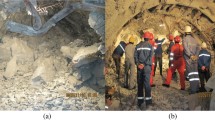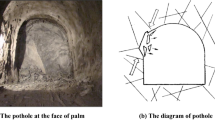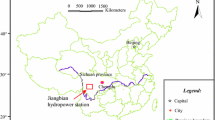Abstract
Rock burst is a dynamic process involving the sudden release of elastic energy accumulated in overstressed rocks and coal masses during underground excavations, capable of causing a great number of fatalities, failure of supporting structures, and damage to equipment. To minimize the risk, a fuzzy comprehensive assessment model was established to predict and evaluate rock burst in underground caverns, and some indices were selected and analyzed. The result vectors and weight vectors were expressed by interval numbers and the membership degrees were determined by a sigmoid membership function. In addition, synthetic weight was obtained by combining subjective weight with objective weight, and final vectors were categorized into different levels through possibility ranking analysis. Finally, the proposed method was applied to a practical case, the Jiangbian hydropower station in China, for further verification. Considering that some indices were conceptually dependent on one another, the multicollinearity of these indices was evaluated according to results based on different indicator systems. The evaluation results showed a high consistency with the actual situation. Moreover, the indicator system, which made full use of the obtained data, had more reliable results than other indicator systems. The proposed fuzzy comprehensive assessment method provides valuable guidance for rock burst assessment.




Similar content being viewed by others
References
Adoko AC, Gokceoglu C, Wu L, Zuo QJ (2013) Knowledge-based and data-driven fuzzy modeling for rockburst prediction. Int J Rock Mech Min 61(4):86–95
Aliyu MM, Shang J, Murphy W, Lawrence JA, Collier R, Kong F, Zhao Z (2019) Assessing the uniaxial compressive strength of extremely hard cryptocrystalline flint. Int J Rock Mech Min Sci 113:310–321
Cai M (2013) Principles of rock support in burst-prone ground. Tunn Undergr Space Technol 36:46–56
Cai W, Dou LM, Zhang M, Cao WZ, Shi JQ, Feng LF (2018) A fuzzy comprehensive evaluation methodology for rock burst forecasting using microseismic monitoring. Tunn Undergr Space Technol 80:232–245. https://doi.org/10.1016/j.tust.2018.06.029
Chen SY, Guo Y (2005) Model of variable fuzzy sets and its application to classification prediction of rockburst. Chin J Rock Mech Eng 24:4603–4609
Chen BR, Feng XT, Li QP, Luo RZ, Li S (2015) Rock burst intensity classification based on the radiated energy with damage intensity at Jinping II hydropower station, China. Rock Mech Rock Eng 48(1):289–303
Cook NGW, Hoek E, Pretorius JP, Ortlepp WD, Salamon MDG (2016) Rock mechanics applied to study of rockburst. J South Afr Inst Min Metall 66(10):435–528
Du K, Tao M, Li XB, Zhou J (2016) Experimental study of slabbing and rockburst induced by true-triaxial unloading and local dynamic disturbance. Rock Mech Rock Eng 49(9):3437–3453
Gong J, Hu NL, Cui X, Wang XX (2014) Rock burst tendency prediction based on AHP-TOPSIS evaluation model. Chin J Rock Mech Eng 33(7):1442–1448
Guo YH, Jiang F (2010) Application of comprehensive fuzzy evaluation in burst-proneness risk of coal seam. Int Conf Future Inf Technol Manag Eng IEEE 38(6):404–407
Hao J, Shi KB, Wang XL et al (2016) Application of cloud model to rating of rockburst based on rough set of FCM algorithm. Rock Soil Mech 37(3):859–866
He MC, Miao JL, Feng JL (2010) Rock burst process of limestone and its acoustic emission characteristics under true-triaxial unloading conditions. Int J Rock Mech Min 47(2):286–298
Hu J, Li S, Li L, Shi S, Zhou Z, Liu H, He P (2018) Field, experimental, and numerical investigation of a rockfall above a tunnel portal in southwestern China. Bull Eng Geol Environ 77(4):1365-1382
Huang BX, Liu CY, Fu JH, Guan H (2011) Hydraulic fracturing after water pressure control blasting for increased fracturing. Int J Rock Mech Min 48(6):976–983
Huang YR, Mao JX, Lin CY, Li SL, Hu JY (2014) The multi-criteria evaluation of rockburst proneness on deep buried large tunnel. J Railw Eng Soc 31(7):89–94
Jia YP, Lv Q, Shang YQ, Du LL, Zhi MM (2014) Rockburst prediction based on rough set and ideal point method. J Zhejiang Univ 48(3):498–503
Jiang Q, Feng XT, Xiang TB, Su GS (2010) Rockburst characteristics and numerical simulation based on a new energy index: a case study of a tunnel at 2500m depth. Bull Eng Geol Environ 69(3):381–388
Kidybiński A (1981) Bursting liability indices of coal. Int J Rock Mech Min 18(4):295–304
Kong F, Shang J (2018) A validation study for the estimation of uniaxial compressive strength based on index tests. Rock Mech Rock Eng 51(7):2289–2297
Li QD, Han GZ, Zeng WY, Yu XC (2016) Ranking method of interval numbers based on Boolean matrix. Control and Decision 31(4):629–634
Li N, Feng X, Jimenez R (2017) Predicting rock burst hazard with incomplete data using Bayesian networks. Tunn Undergr Space Technol 61:61–70
Liu Q, Chen X, Wu Z, Liu X (2013a) Determination method of nonlinear membership function based on the fuzzy density means cluster. Res J Appl Sci Eng Technol 5(8):2527–2530
Liu ZB, Shao JF, Xu WY, Meng YD (2013b) Prediction of rock burst classification using the technique of cloud models with attribution weight. Nat Hazards 68(2):549–568
Miao SJ, Cai MF, Guo QF, Huang ZJ (2016) Rock burst prediction based on in-situ stress and energy accumulation theory. Int J Rock Mech Min 83:86–94
Peng Q, Qian A, Xiao Y (2010) Research on prediction system for rockburst based on artificial intelligence application methods. J Sichuan Univ Eng Sci Ed 42(2):18–24
Peng YH, Peng K, Zhou J, Liu ZX (2014) Prediction of classification of rock burst risk based on genetic algorithms with SVM. Appl Mech Mater 628:383–389
Qiu D, Zhang L, Li S, Zhang D (2011) Application of ideal point method in Rockburst prediction based on weight back analysis method. GeoHunan Int Conf. https://doi.org/10.1061/47631(410)31
Russenes BF (1974) Analysis of rock spalling for tunnels in steep valley sides (in Norwegian) Master Thesis of Science, Norwegian Institute of Technology, Trondheim
Saaty TL, Vargas LG (1987) Uncertainty and rank order in the analytic hierarchy process. Eur J Oper Res 32(1):107–117
Shan ZG, Yan P (2010) Management of rock burst during excavation of the deep tunnels in Jinping II hydropower station. Bull Eng Geol Environ 69(3):353–363
Shang YJ, Zhang JJ, Fu BJ (2013) Analyses of three parameters for strain mode rockburst and expression of rockburst potential. Chin J Rock Mech Eng 32(8):1520–1527
Sun J, Wu J, (2014) Optimization study on interval number judgment matrix weight vector based on immune evolution algorithm. International Journal of Security and Its Applications 8(3):355–362
Tang LZ, Wang WX (2002) A new index of rock burst proneness. Chin J Rock Mech Eng 21(6):874–878
Turchaninov A, Markov GA, Gzovsky MV et al (1972) State of stress in the upper part of the Earth’s crust based on direct measurements in mines and on tectonophysical and seismological studies. Phys Earth Planet Inter 6:229–234
Wang C, Peng W (2014) Rockburst prediction based on electromagnetic radiation technology and its application. Adv Mater Res 1010:1564–1567
Wang C, Lin L, Liu J (2012) Uncertainty weight generation approach based on uncertainty comparison matrices. Appl Math 3(5):499–507
Wang XT, Li SC, Xu ZH, Hu J, Pan DD, Xue YG (2018) Risk assessment of water inrush in karst tunnels excavation based on normal cloud model. Bull Eng Geol Environ. https://doi.org/10.1007/s10064-018-1294-6
Wang XT, Li SC, Xu ZH, Lin P, Hu J, Wang WY (2019) Analysis of factors influencing floor water inrush in coal mines: a nonlinear fuzzy interval assessment method. Mine Water Environ. https://doi.org/10.1007/s10230-018-00578-x
Xue YG, Li ZQ, Li SC, Qiu DH, Tao YF et al (2017) Prediction of rock burst in underground caverns based on rough set and extensible comprehensive evaluation. Bull Eng Geol Environ. https://doi.org/10.1007/s10064-017-1117-1
Yang J, Wu X (2005) Comprehensive forecasting method for estimating rock burst. Chin J Rock Mech Eng 24(3):411–416
Yu HC, Liu HN, Lu XS, Liu HD (2009) Prediction method of rock burst proneness based on rough set and genetic algorithm. J Coal Sci Eng 15(4):367–373
Zhang C, Zhou H, Qiu S, Wu W (2012) A top pilot tunnel preconditioning method for the prevention of extremely intense rockburst in deep tunnels excavated by TBMS. Rock Mech Rock Eng 45(3):289–309
Zhang Y, Xiao PX, Chen LJ (2014) Method of layout design based on ratio of rock strength to in-situ stress for large underground caverns. Chin J Rock Mech Eng 33(11):2314–2331
Zhang Y, Liang P, Liu X, Liu S, Tian B (2015) Experimental study on precursor of rock burst based on acoustic emission signal dominant-frequency and entropy. Chin J Rock Mech Eng 34:2959–2967
Zhao S, Chai LH (2015) A new assessment approach for urban ecosystem health basing on maximum information entropy method. Stoch Env Res Risk A 29(6):1601–1613
Zhou KP, Lin Y, Deng HW, Li JL, Liu CJ (2016) Prediction of rock burst classification using cloud model with entropy weight. Trans Nonferrous Metal Soc China 26(7):1995–2002
Acknowledgments
Much of the work presented in this paper was supported by the National Natural Science Foundation of China (Grant Nos. 51879153, 51422904, 51379112, 41877239) and the Fundamental Research Funds of Shandong University (Grant Nos. 2017JC001, 2017JC002).
Author information
Authors and Affiliations
Corresponding authors
Appendix
Appendix
For the interval number X = [a, b] and Y = [c, d], the binary arithmetic rule to which the interval number should be followed (Sun and Wu 2014) are shown in the following formula:
Rights and permissions
About this article
Cite this article
Wang, X., Li, S., Xu, Z. et al. An interval fuzzy comprehensive assessment method for rock burst in underground caverns and its engineering application. Bull Eng Geol Environ 78, 5161–5176 (2019). https://doi.org/10.1007/s10064-018-01453-3
Received:
Accepted:
Published:
Issue Date:
DOI: https://doi.org/10.1007/s10064-018-01453-3




